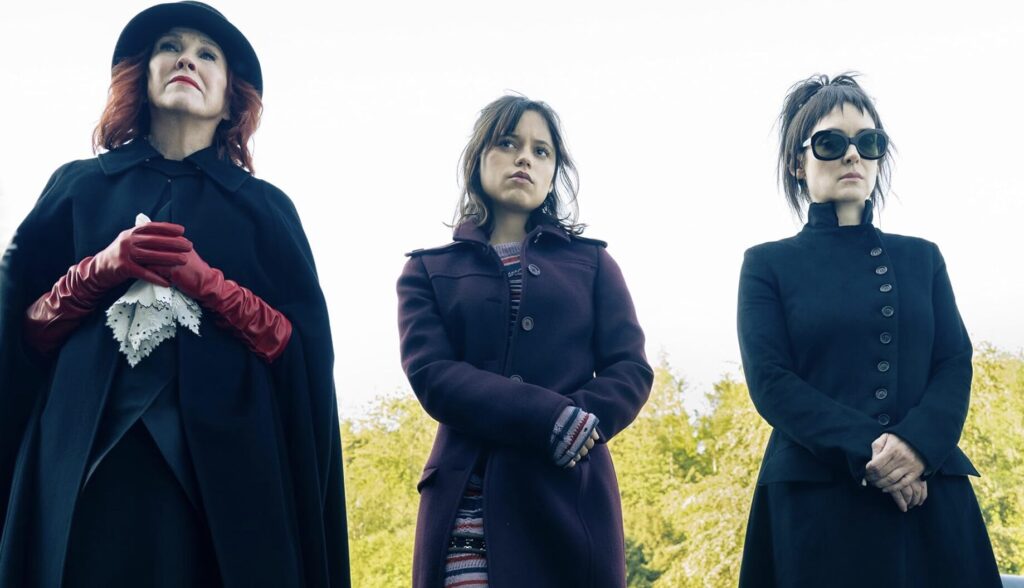“Beetlejuice Beetlejuice” Trades the Monster For a Matriarchy

Tim Burton has a distinctive style. After 20 feature films and a handful of TV entries, his particular brand of dark whimsy has ingrained itself into our public consciousness and become an adjective we use to describe all things joyfully macabre. But before the visionary spookster and his charmingly grisly characters became household names, Burton was a fledgling director trying to plant his flag in the cinematic landscape. His 1988 film Beetlejuice did just that. This surprisingly sweet story about families connecting across death’s divide solidified Michael Keaton as a versatile star and created one of horror’s most beloved supernatural bad boys. Thirty-six years later, we return to Burton’s afterlife and catch up with these friends and foes as they deal with a web of tangled romance. While an excess of plot bogs the film down, it’s the Deetz matriarchy that rises to the top.
Decades after the Deetz and Maitland families agreed to coexist, their coveted house on the hill stands empty. Delia (Catherine O’Hara) has become a world-renowned experimental artist in New York City and Lydia (Winona Ryder) is hosting a paranormal talk show. Her teenage daughter Astrid (Jenna Ortega) begrudgingly attends her family’s boarding school for the arts while estranged from her mother due to her father’s death. Lydia’s inability to see and communicate with him from beyond the grave has driven a wedge between mother and daughter. Also irking the moody teen is Lydia’s relationship with Rory (Justin Theroux), a clingy TV producer who has mastered the art of weaponized therapy speak. With the family reunited for Charles’ funeral, Lydia reluctantly accepts Rory’s marriage proposal causing Astrid to flee. She crashes her bike into a tree in town, inadvertently sparking a meet-cute with a local bookworm named Jeremy (Arthur Conti) who also enjoys the strange and unusual. All this commotion catches the attention of a familiar ghoul, now running his own nefarious underworld agency. But it seems Betelgeuse (Keaton) may have problems of his own. A mysterious soul-sucker named Delores (Monica Bellucci) has set her sights on the demonic bio-exorcist and only a deceased TV detective named Wolf Jackson (Willem Dafoe) can track her down.
If this feels like a lot of details, you’re not alone. Perhaps the biggest failing of this highly anticipated sequel is the sheer volume of story weighing it down. Not one, but four different subplots compete for attention, preventing us from ever becoming emotionally invested. We go long stretches of time without the title character and every time Defoe and Belucci reappear, we realize we’d forgotten they were part of the tale to begin with. Belucci feels particularly wasted as an undead seductress who lurks around the periphery of the film. We learn almost nothing about this glamorous corpse and her story could easily have been saved for another sequel. Defoe feels similarly wasted as a self-obsessed actor pretending to play cops. While funny and gruesome, this superfluous addition only serves to tie Betelgeuse to the afterlife and provide a motive for his escape.
Thankfully, the Deetz matriarchy emerges as the heart of the film. Now a widow, Delia has repaired her relationship with Lydia and the two mothers connect over the wayward Astrid. Scenes between these beloved actresses crackle and it’s fun to see three generations of flawless divas join forces against nefarious men. All plots revolve around romance, but each woman resists being defined by her partner. Instead, she gets a chance to decide what she truly wants and find a way back to her true soulmate. Though the film is named for him, Betelgeuse occasionally feels like an afterthought. It’s certainly fun to see Keaton once again don the iconic stripes and he seems to be having a ball with the demonic trickster, but Burton is much more interested in his female characters.
Rounding out the male cast, Theroux is a welcome addition to this macabre world as Lydia’s simpering, but manipulative paramor. In a debut role, Arthur Conti stands out as mysterious heartthrob Jeremy, who’s cozily messy home may contain its own sinister secrets. Unfortunately, these two plotlines dissolve rather quickly and the stakes feel frustratingly low. Charles Deetz also has a substantial role in the film, though Jeffrey Jones does not reappear. His death is a catalyst for the story and Burton goes out of his way to punish Charles while allowing Delia to mourn the inoffensive character. A single still image on his elaborate tombstone is the only trace of the disgraced actor’s face, but he continues to pop up as a mangled corpse and plays a surprisingly tender role in the overall story.
Despite a jumbled plot and overstuffed cast, Beetlejuice Beetlejuice looks fantastic. The autumnal vibes are immaculate and blacklight afterlight sequences pop with creative color, dismemberment, and gore. A musical number to “MacArthur Park” is a fun nod to the original film, though nothing will ever top the bizarre perfection of “Day-O (The Banana Boat Song).” With gorgeously staged set pieces and an abundance of darkly comedic sight gags, Burton is back to what he does best: creating grisly depictions of death and decay that remain charming and still accessible to kids. The original Beetlejuice was a slumber party staple and introduced a generation to the horror genre. Though bursting at the seams with plot and personnel, Beetlejuice Beetlejuice will likely stand the test of time and emerge as a similarly popular model for gateway horror.
Jenn Adams is a writer, podcaster, and film critic from Nashville, TN. Find her social media nonsense @jennferatu.